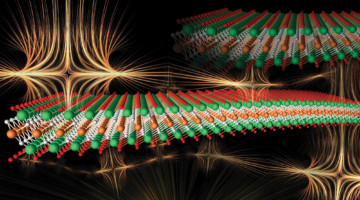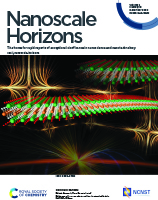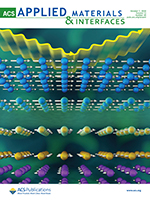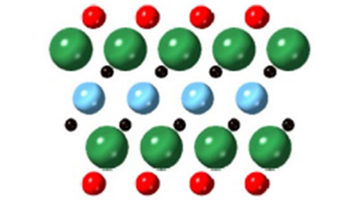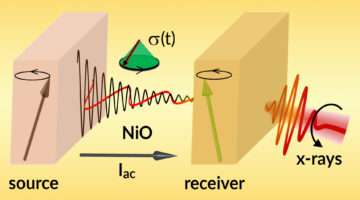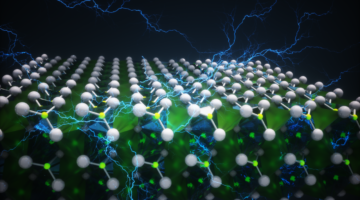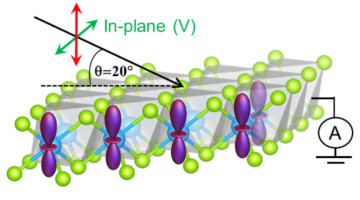A variety of experiments, including ALS x-ray studies, provided direct evidence of a magnetic transition in a 2D compound called a MXene (pronounced “maxene”). The finding adds new functionality to a family of materials with numerous ways to fine-tune properties for applications ranging from spintronic devices to electromagnetic shielding. Read more »![]()
![]()
From Stripes to Skyrmions in a Surprising Material
Researchers showed that tiny bubbles of ordered spins (skyrmions) can be induced to form in a material previously considered incompatible with skyrmion formation. The discovery opens up a new class of material systems that exhibit technologically desirable nanoscale features attractive for spintronic applications. Read more »![]()
![]()
Evidence of a magnetic transition in atomically thin Cr2TiC2Tx MXene
2D magnetic materials have recently attracted significant interest as model systems to understand low-dimensional magnetism and for potential spintronic applications. Here, we report on synthesis of Cr2TiC2Tx MXene and a detailed study of its magnetic as well as electronic properties. Read more »
Controlling Magnetization Vector Depth Profiles of La0.7Sr0.3CoO3/La0.7Sr0.3MnO3 Exchange Spring Bilayers via Interface Reconstruction
Polarized neutron reflectometry was combined with soft x-ray magnetic spectroscopy to quantify the changes in the magnetic and chemical depth profiles in La0.7Sr0.3CoO3/La0.7Sr0.3MnO3 bilayers, confirming the formation of interfacial layers with distinct magnetization and chemical density. Read more »
Understanding Electronic Structure in MXenes, One Atomic Layer at a Time
MXenes are 2D materials that can host a rich array of distinct chemical compositions that can be tuned for a broad range of applications, from energy storage to water purification. Site-specific x-ray absorption spectroscopy helped identify the unique roles of surface and subsurface transition-metal atoms in Ti-based MXenes. Read more »
Antiferromagnet Transmits Coherent Spin Waves
Researchers discovered how pure spin currents (also known as spin waves) can be efficiently and coherently transmitted through an electrically insulating antiferromagnetic material. The work represents a notable milestone in the use of antiferromagnetic materials for low-power spintronic devices at room temperature. Read more »![]()
![]()
Unexpected Rise in Ferroelectricity as Material Thins
Researchers showed that hafnium oxide surprisingly exhibits enhanced ferroelectricity (reversible electric polarization) as it gets thinner. The work shifts the focus of ferroelectric studies from more complex, problematic compounds to a simpler class of materials and opens the door to novel ultrasmall, energy-efficient electronics. Read more »![]()
![]()
Anomalous Orbital Structure in Two-Dimensional Materials
Researchers explored how structural distortions of the atomic lattice influence exotic electronic states in two-dimensional transition-metal dichalcogenides (TMDs). Polarization-dependent spectroscopy revealed an unexpectedly large crystal-field splitting of the valence electron states, a result of strong hybridization in metal–chalcogen orbitals. Read more »
Padraic Shafer to Receive the 2019 Shirley Award
Congratulations to Padraic Shafer, this year’s recipient of the Shirley Award for Outstanding Scientific Achievement! Shafer, ALS staff scientist and leader of the ALS’s dichroism program, is being recognized “for unveiling the nature of chiral quantum materials through the innovative use of x-ray scattering at the Advanced Light Source.” Read more »
Controlling Spin in Antiferromagnetic Nanostructures
Researchers discovered that the spin configuration of a nanostructured antiferromagnetic material can be affected by the dimensions of features imprinted onto the material. The results suggest that nanoscale patterning can be a viable tool for engineering spin configurations in future antiferromagnetic spintronic devices. Read more »![]()
![]()
